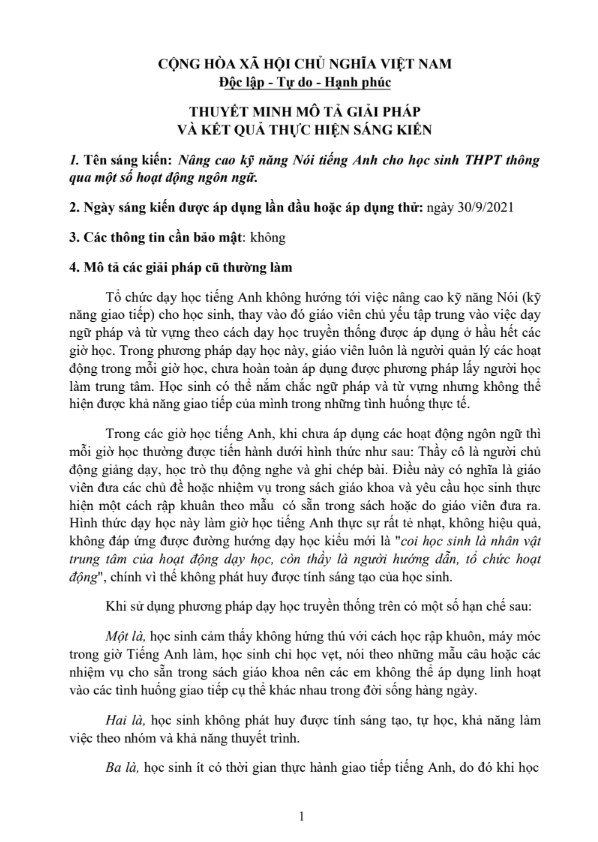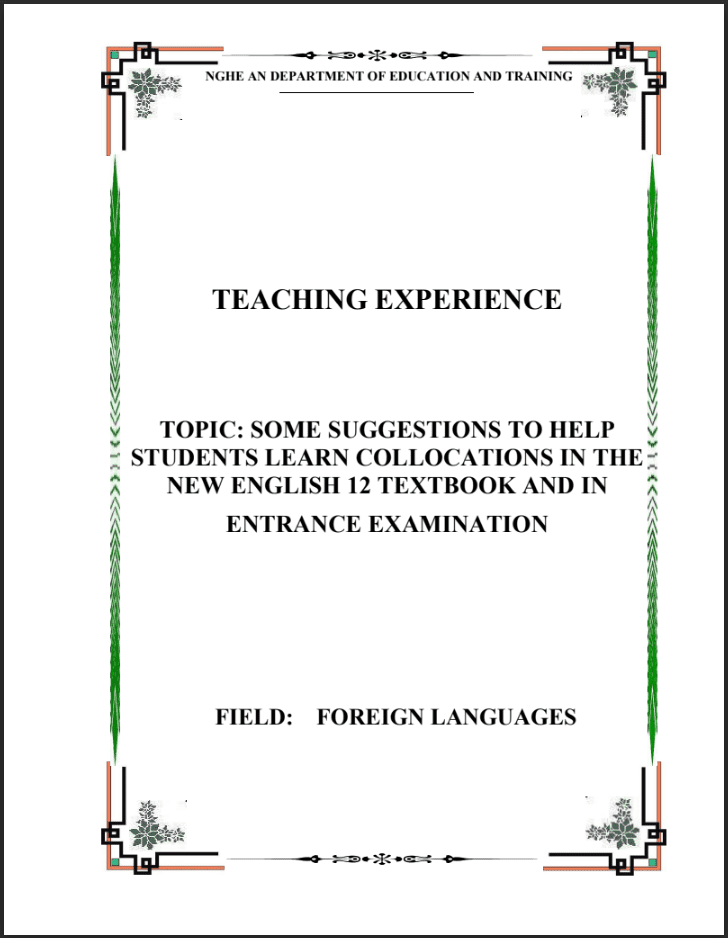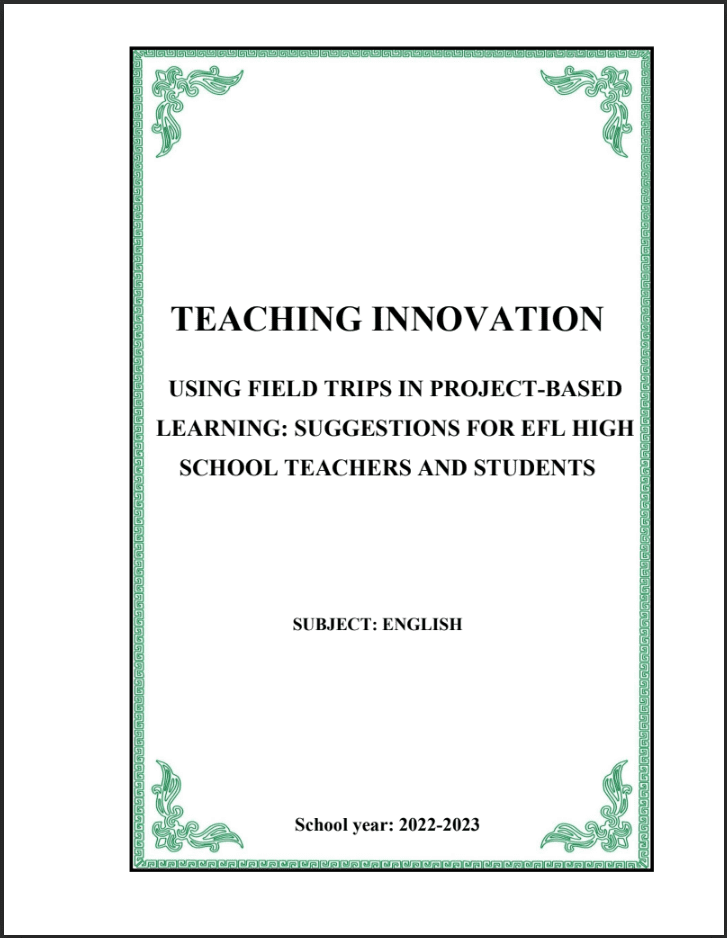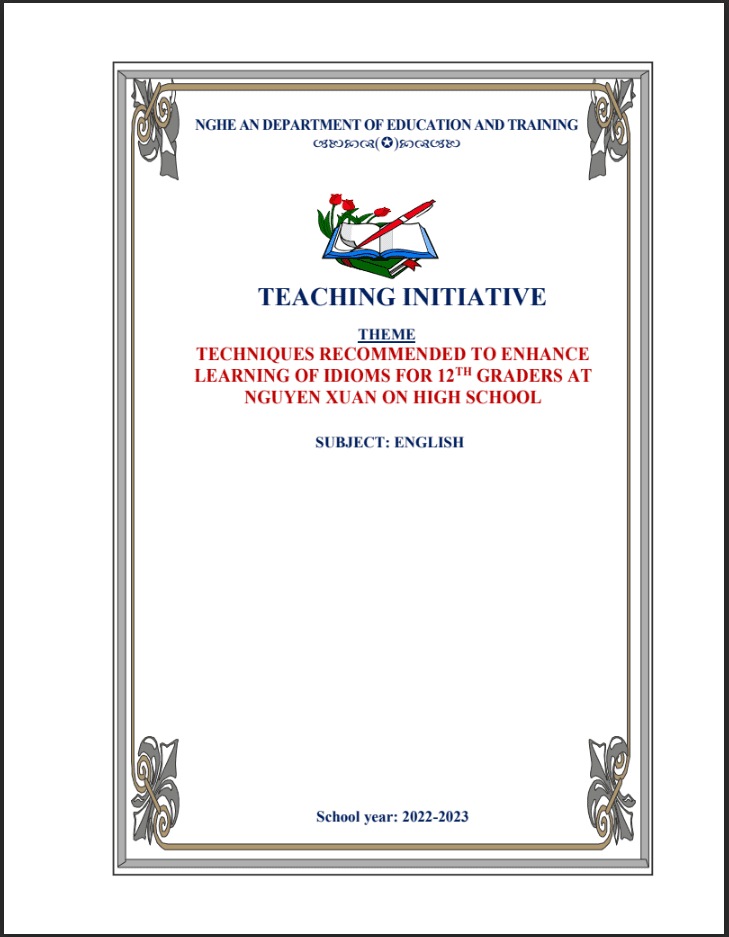SKKN Using learning stations to engage students and promote autonomy in English lessons in the new english textbook 10
- Mã tài liệu: MP0021 Copy
| Môn: | Tiếng anh |
| Lớp: | 10 |
| Bộ sách: | |
| Lượt xem: | 1852 |
| Lượt tải: | 4 |
| Số trang: | 43 |
| Tác giả: | Phạm Thị Ngân |
| Trình độ chuyên môn: | Thạc sĩ giáo dục |
| Đơn vị công tác: | THPT Hoàng Mai 2 |
| Năm viết: | 2021-2022 |
| Số trang: | 43 |
| Tác giả: | Phạm Thị Ngân |
| Trình độ chuyên môn: | Thạc sĩ giáo dục |
| Đơn vị công tác: | THPT Hoàng Mai 2 |
| Năm viết: | 2021-2022 |
Sáng kiến kinh nghiệm “SKKN Using learning stations to engage students and promote autonomy in English lessons in the new english textbook 10” triển khai gồm các biện pháp nổi bật sau:
2.1. Process of designing and teaching by learning stations
2.2. Designing lesson plans
Mô tả sản phẩm
PART I: INTRODUCTION
1. Rationale of the study
The new general education program in the subject of English of the Ministry of Education and Training aims at equipping students with communicative competence, language skills and attitudes. Traditional teacher-centred learning which focuses on completing tests and examinations instead of enhancing students’ productive skills will no longer be effective in preparing students for new challenges in the new millennium.
The 21st-century teaching and learning demands educators to change their practice from a teacher-centred to a more diverse student-centred learning environment. The notion of student-centred learning originates from the constructivist theory, which denotes the role of the students as active and central in the learning process. In a successful student-centred learning environment, students have greater control of their learning, in which they are allowed to create their own learning goals, consider strategies, and make decisions to achieve these goals. This engaging process makes learning more meaningful and promotes higher thinking skills.
In addition, one of the biggest challenges that teachers face in the classroom is how to liven lessons, especially reading and writing lessons. I sought to determine the techniques that would improve students’ motivation and enable students to develop more language skills as well as complex learning strategies.
The matter above inspired me to deal with the topic: “Using learning stations to engage students and promote autonomy in English lessons in the new english textbook 10.”
2. Aims of the study
This study aims at designing activities for reading lessons in new english textbook 10 to engage learners in learning english, encourage them to focus on the meaning and function of language rather than specific forms, and promote students’ autonomy in a fun and interactive environment.
3. Scope of the study
- Applying in the reading, writing and review lessons in English 10
- Applying to get students involve in the lessons
4. Object of study:
– Students in grade 10 at Hoang Mai 2 high school
5. Method of the study
- Collecting a wide range about the reality of our school’s students from colleagues
- Studying theoretical background of learning station method to develop learner’s competence
- Reading reference books, discussing with other teachers, applying in teaching, and getting experience from the teaching in the class.
PART II: MAIN CONTENT
1. Theoretical and practical background
1.1. Theoretical background
1.1.1 Definition of station
Station is a stable place where people solve or deal with an issue. Learning station is a place where a group of students themselves organize learning activities (doing experiment, taking a task, dealing with a learning problem that they need to solve, etc.). Stations give students ample opportunities to use aids and materials, assure active student participation in the learning process, and thus the learnt knowledge is made permanent.
Teaching using learning station method is that teachers organize for their students to work by themselves at different stations in the classroom to complete their learning tasks. Learning stations are designed in different places organized in or outside the classroom and students’ activities at different stations are free with the instruction of teachers. Students must solve issues at different levels of learning by themselves. Thus, learning station method focuses on self-control and self-study of students.
1.1.2. Factors effecting learning station method
- Classroom: One important factor is the relationship between the number of students and classroom area. In some activities, the learning process can take place outside the classroom. However, for activities in the classroom, it is desirable to have a room with enough space.
- Students’ self-orientation: What are the levels of students’ self-orientation and independence in fulfilling tasks? The higher the students’ ability to self-orient, the easier it will be for the teacher to organise the classroom. As such, students will be free to be creative. And naturally, they will have more than one opportunity to fulfill their taks. And the situation changes from the teacher controlling the classroom (outside orientation) to children having every opportunity to give their opinions.
- Materials: The implementation of learning stations depends much on the quality of available materials. Which kind of classroom environment can we create? What materials are available? Such questions should be taken into consideration before we start organising learning stations in the classroom.
- Scope: The teacher will decide how much time to allow for learning station activities. The scope of learning stations depends on the formula and content suggested by the teacher.
1.1.3. Advantages of learning station method
According to Manuel (Manuel, 1974), using Learning station method brings many benefits for students, for example:
- Students will know how to work cooperatively in groups: Students learn themselves how to collaborate with their peers, improve their debate skills, social skills, develop critical thinking, and problem solving.
- Students will develop independent work habits: Independence in studying is very important for students because they must solve different issues without teachers’ explanation in detail. They only receive teacher’s instruction in general and students themselves will be active in dealing tasks at different stations, develop their own speed of working.
- Students will plan their time more effectively: Students can move from a station to another station after finishing a task; they do not need to sit at their seats too long to feel bored because elementary students love movement, and they are more excited if they can move around stations. The movement among stations not only brings students the excitement but also give them new challenges that they need to conquer. – Students will discover creative ways of working: One task can bring students many ways to deal with and each student has his/her own solution or cognitive thinking to reach their targets.
- Students will know how to explore areas of interest: Student can choose the way they like to work at a station and what station they want to go first. Students can decide by themselves their own routes.
- Students have chance for additional practice in fields that they are struggled: learning stations are great places for students to focus on fields that they need to practice more. Student can spend more time at stations that they need to practice until they feel comfortable and can thoroughly apply knowledge to reality.
- Students will understand evaluating techniques and know how to use evaluating methods: Students used self-assessment scale to evaluate themselves and their peers.
In addition, Schweitzer (Schweitzer, 1995) mentioned the effectiveness of learning stations strategy in enhance students’ learning and critical thinking because it creates opportunities for students to have responsibility for their learning environment.
1.1.4. Disadvantages of learning station method
Learning stations also display certain disadvantages:
TÀI LIỆU LIÊN QUAN
- 7
- 105
- 1
- [product_views]
- 5
- 173
- 2
- [product_views]
- 4
- 165
- 3
- [product_views]
- 4
- 129
- 4
- [product_views]
100.000 ₫
- 6
- 434
- 5
- [product_views]
100.000 ₫
- 2
- 507
- 6
- [product_views]
100.000 ₫
- 9
- 546
- 7
- [product_views]
100.000 ₫
- 4
- 409
- 8
- [product_views]
100.000 ₫
- 2
- 595
- 9
- [product_views]
100.000 ₫
- 0
- 538
- 10
- [product_views]















